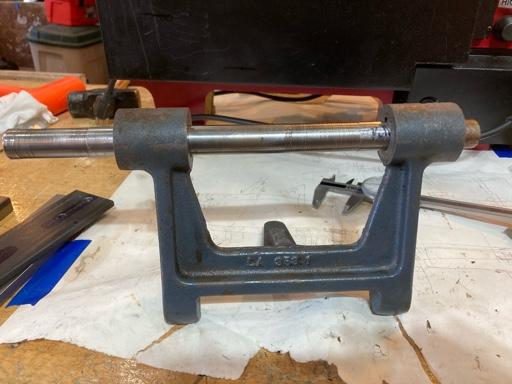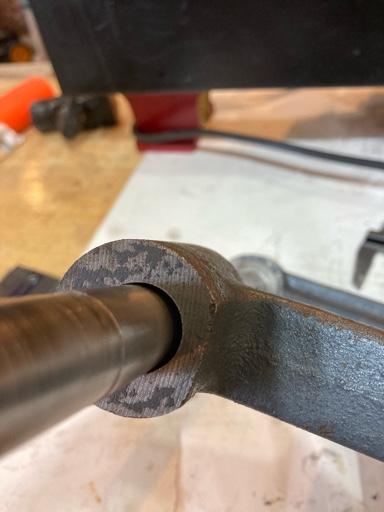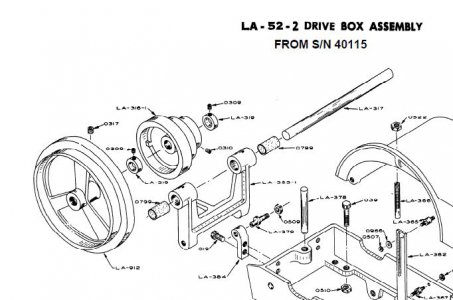I could use some advice on what people think is the best way to repair my counter-shaft casting.
I had a chance to disassemble my Logan 820 countershaft that had significant wear. I was hoping to see bushings that could be replaced but on my model, the ¾ inch shaft runs directly in the cast iron casting.
I am still quite new to this hobby and my skills are getting better but still limited. I have another Logan 10” lathe to use and a Van Norman 12 Milling machine and other small equipment to attempt repair.
The ¾ inch shaft is badly worn and can easily be replaced. I was thinking that drill rod might be a good shaft material since it is quite accurately sized and strong. If you have other suggestions please let me know what you think.
The casting however is a larger problem for me. The “non pully” end is still quite close to the shaft diameter and seems quite round when looking at it without measuring.
The pulley side of the casting, however, is very wallowed out with a very visible oval wear pattern with the oval shape being drawn down in the direction of the motor, possibly caused by excessive belt tension and little lubrication. Pictures are below, but crude measurements are almost 1/8 inch of wear in casting.
Now how to repair this? My first thoughts are to bore the holes to a larger size and use bronze bushings of the correct size. The only machined surfaces on the casting are the areas where the holes have been bored. How do I set up the casting to allow boring accurately without line boring capability? Secondly, although the castings are quite thick, a busing large enough to take care of the 1/8 inch wallow would need to be around one inch which doesn’t leave a lot of cast iron remaining for strength. How little is acceptable.
My second thought on the casting repair was to braze the wallowed out portion to a smaller size and use the better hole to guide a custom made cutter (I would make) of ¾ inch size to “bore” out the excess brass material. I’ve not done much brazing and not sure of getting that large a part hot enough with my small torch to get a good braze.
My third thought was to use something like Babbitt with a much lower melting point and fill the wallowed hole completely and then use the custom made cutter I would make to “bore” the hole using the better hole as a guide.
Fourth thought, send out the part to someone with line boring capabilities willing to do a small job.
I could sure use your thought and advice on what you folks might do to repair this part. I’m sure there are many other ways I have not thought of and my limited experience and equipment might limit my options.
John from Minnesota


Sent from my iPhone using Tapatalk
I had a chance to disassemble my Logan 820 countershaft that had significant wear. I was hoping to see bushings that could be replaced but on my model, the ¾ inch shaft runs directly in the cast iron casting.
I am still quite new to this hobby and my skills are getting better but still limited. I have another Logan 10” lathe to use and a Van Norman 12 Milling machine and other small equipment to attempt repair.
The ¾ inch shaft is badly worn and can easily be replaced. I was thinking that drill rod might be a good shaft material since it is quite accurately sized and strong. If you have other suggestions please let me know what you think.
The casting however is a larger problem for me. The “non pully” end is still quite close to the shaft diameter and seems quite round when looking at it without measuring.
The pulley side of the casting, however, is very wallowed out with a very visible oval wear pattern with the oval shape being drawn down in the direction of the motor, possibly caused by excessive belt tension and little lubrication. Pictures are below, but crude measurements are almost 1/8 inch of wear in casting.
Now how to repair this? My first thoughts are to bore the holes to a larger size and use bronze bushings of the correct size. The only machined surfaces on the casting are the areas where the holes have been bored. How do I set up the casting to allow boring accurately without line boring capability? Secondly, although the castings are quite thick, a busing large enough to take care of the 1/8 inch wallow would need to be around one inch which doesn’t leave a lot of cast iron remaining for strength. How little is acceptable.
My second thought on the casting repair was to braze the wallowed out portion to a smaller size and use the better hole to guide a custom made cutter (I would make) of ¾ inch size to “bore” out the excess brass material. I’ve not done much brazing and not sure of getting that large a part hot enough with my small torch to get a good braze.
My third thought was to use something like Babbitt with a much lower melting point and fill the wallowed hole completely and then use the custom made cutter I would make to “bore” the hole using the better hole as a guide.
Fourth thought, send out the part to someone with line boring capabilities willing to do a small job.
I could sure use your thought and advice on what you folks might do to repair this part. I’m sure there are many other ways I have not thought of and my limited experience and equipment might limit my options.
John from Minnesota


Sent from my iPhone using Tapatalk


